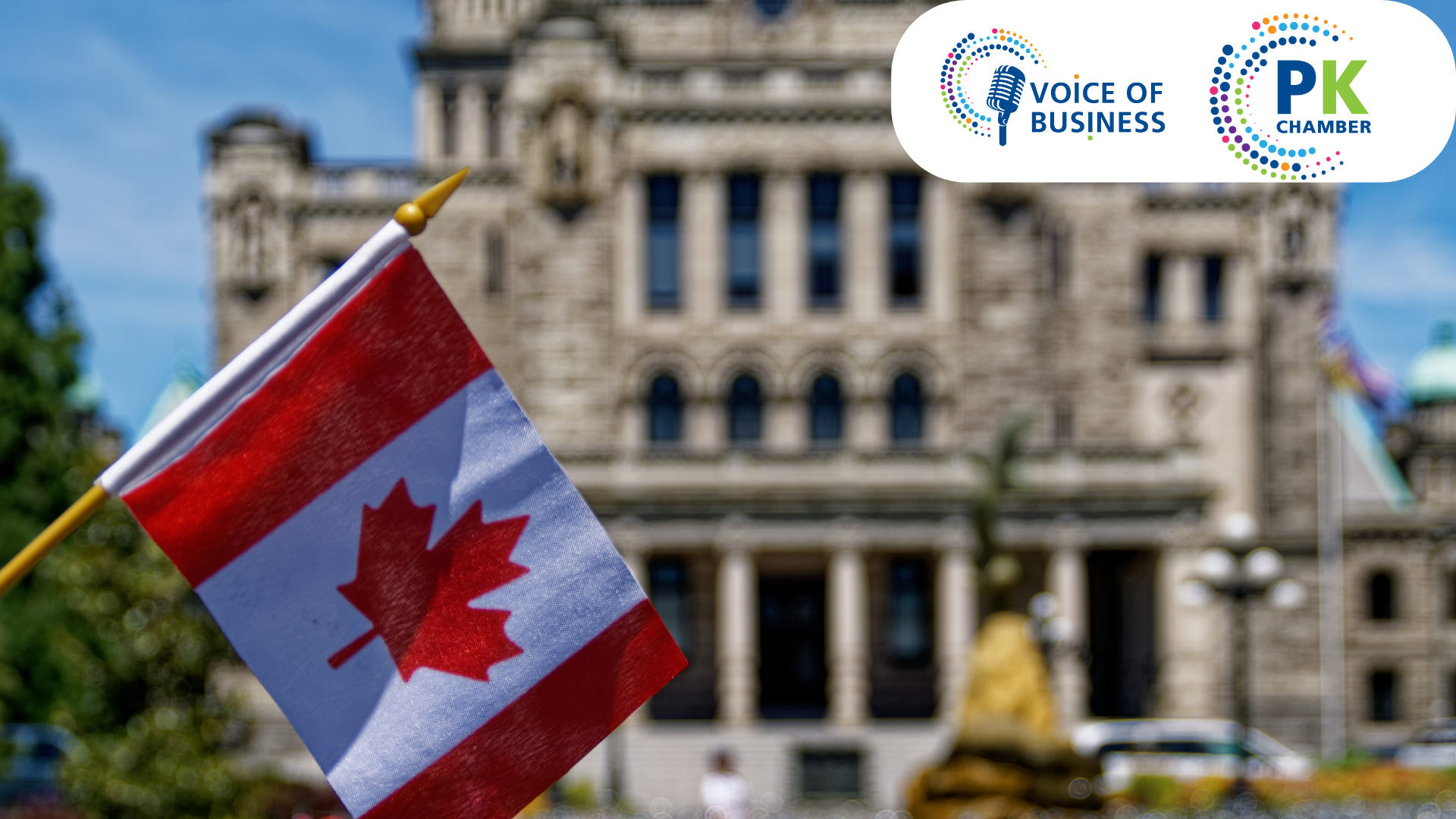Peterborough Blogs
Voice of Business: Collaborating to Build a Stronger Business Environment in Peterborough
/Welcome back to this week’s Voice of Business. This week, we’re discussing what can be done to support a thriving business community within Peterborough County.
This past week, we held a roundtable with local government leaders to address key community concerns. Market changes are inevitable and often uncontrollable. The world is changing rapidly, but the question remains: what can we do to help offset future market impacts and support our local business economy?
One of the main themes discussed was the importance of upskilling our workforce and leveraging government funding to support local business growth. A key point raised was the economic uncertainty that continues to stifle business investment. While we can’t always predict what’s next, we can take proactive steps to support our economy. That includes finding innovative ways to create certainty, whether through technology, workforce development, or market insights, to help ground our local businesses so they can weather change rather than be overtaken by it. One such strategy discussed was bridging research opportunities for local businesses with our local post-secondary institutions.
There was consensus around the role our post-secondary institutions can play, both in workforce development and in business support. Connecting local businesses with colleges and universities helps fill labour shortages while also offering access to applied research and innovation. When research expertise is paired with private sector resources, the result can be meaningful breakthroughs in intellectual property and competitive advantage. Building stronger partnerships between academia and business is essential to spurring innovation and strong economic growth.
Another issue raised during the discussion was the importance of business attraction. Both the County and City of Peterborough have recently developed strong economic development teams to support our region’s economic goals. Our local economic development teams have plenty of positive things to position Peterborough as an appealing place for growth. Peterborough acts as a central hub and is in close proximity to Highway 407. The City has made major investments to modernize public transit, and with the potential of becoming a stop on the future high-speed rail line, our region is becoming increasingly well-positioned for investment. These infrastructure improvements, combined with Peterborough’s quality of life and available talent from post-secondary institutions, offer compelling reasons for businesses to consider setting up here.
There was also a strong interest in pivoting our economic development strategy toward targeting the technology sector. With the increasing reliance on AI and emerging tech solutions, there is an opportunity to attract companies that specialize in these areas to help meet local business challenges and fuel innovation. Peterborough’s growing appeal as a livable, mid-sized city makes it a strong candidate for this kind of targeted investment.
Recent government supports were also discussed. The Province recently released a grant for small and medium-sized businesses across Ontario to help digitize their operations. Businesses can receive up to $5,000 in support to adopt and implement digital technologies, hardware, and software. This is an excellent opportunity for businesses to modernize and become more competitive. Additionally, the Province has announced over $1.4 million in new funding to train and upskill 500 individuals for careers in manufacturing or who are already working in the sector. This is a welcomed investment for our manufacturing industry among our other crucial industries such as education, healthcare, and construction! The Chamber supports continued investment from all levels of government to address the evolving labour needs of businesses.
We also heard from businesses that they would like to see one centralized point of communication to stay informed about government support and policy updates. While there are many organizations already doing this, such as our local economic development teams, that have online data centres for businesses interested in setting up in Peterborough. Our Chamber also features a monthly policy newsletter that outlines new grants, investments, and programs from both the provincial and federal governments. We also post weekly policy posts and business resources that businesses can use right at their fingertips.
As your local Chamber, we are committed to supporting your business by proactively bringing you timely information on government support and advocating on your behalf. One of the ways we do this is by creating opportunities for you to share your experiences directly with government officials. Through continued collaboration with government, our post-secondary institutions, and the strategic use of technology and academic partnerships, we can work toward building a more predictable and supportive business environment in our region. When government leaders hear firsthand about the challenges facing our business community, it becomes possible to tailor support programs and policies that foster growth and help businesses thrive.
Content provided by the Peterborough and the Kawarthas Chamber of Commerce.
Engage with us on social media on Twitter, Instagram, Facebook and Tiktok. Write to us at tips@ptbocanada.com. Sign up for PTBOBuzz newsletter here.
Voice of Business: A New Era of Military Spending
/Canada is set to make a historic investment in its military, not seen since the Korean War.
Just last month, Prime Minister Mark Carney announced that Canada will meet the two per cent target by the end of the current fiscal year, totalling over $9 billion. If achieved, this would mark a significant increase from the current level of roughly 1.3 per cent of GDP. This renewed commitment to defence spending reflects not only growing international pressures, such as Canada's NATO obligations, but also recognition of the domestic economic opportunities that could accompany such investment. As government procurement expands to include new technologies, equipment, and infrastructure, Canadian businesses across sectors, from advanced manufacturing to cybersecurity, are likely to see increased demand and opportunities for growth.
The key question is: who will benefit from this? Canada’s defence sector encompasses air and space systems, land, and marine operations. According to Statistics Canada, in 2022, it generated $14.3 billion in revenue from 586 firms. Approximately 408 of those firms were Canadian-owned, collectively accounting for half of the industry’s total sales.
Why is this important to our region? Because Ontario is home to strong manufacturing bases that support areas like combat vehicle production, munitions, and aircraft fabrication and maintenance. In 2022, 54 per cent of total supply chain expenditures across the defence industry were directed to domestic sources.
The Ontario government has also weighed in on investing in Ontario’s defence manufacturing sector, particularly by strengthening its shipbuilding capacity. This will help to support and align with Canada’s National Defence Strategy by providing accessible options for procuring ships domestically. A first-of-its-kind program in Ontario will offer shipbuilders access to non-repayable grants covering up to 50 per cent of eligible costs for projects that enhance the shipbuilding industry’s competitiveness. Ontario is positioning itself to support the shipbuilding sector and contribute to Canada’s defence-building strategy.
While this announcement of federal spending is still in its early stages, and the rollout of government procurement remains to be seen, we can expect a more strategic, Canadian-focused approach that emphasizes “Made in Canada” solutions.
Furthermore, with a significant announcement like this, we can expect the Government of Canada to commit to its goal of doubling defence spending. However, the true test will be whether the government follows through. Canada has consistently been underspending to meet the existing 2 per cent NATO defence requirement.
Within the province, building on previous investments in the shipbuilding sector, Ontario is positioning its industries to help support Canada’s defence spending commitments. This focus includes bolstering Ontario’s own domestically sourced critical minerals, which are essential to the defence industry. In addition, Ontario is investing $50 million into an Ontario-based venture capital fund focused on technologies that support national defence and related fields such as AI and cybersecurity.
More spending means more production, but what does this mean for our manufacturing sector? There is little detail, but Canada has generally outlined their plan. For example, $1 billion (accrual basis) has been allocated to expand and enhance military capabilities with a focus on Canadian suppliers. An additional $2.1 billion (reported on both a cash and accrual basis) will be used to strengthen the federal government’s relationship with the defence industry and support the development of a Defence Industrial Strategy (DIS). These measures aim to address immediate barriers, such as delays and gaps in the industry’s ability to equip the Canadian Armed Forces. Recognizing that Canada cannot meet all military needs alone, this strategy also includes plans to deepen our industrial partnerships and expand our military capabilities.
While the news of Canada’s effort is fairly new, we can only wait and see what will come of this. Canada’s effort to bolster defence will not only protect our national security but also indirectly sustain the continued prosperity and safety of the communities our businesses call home. This move will bring renewed opportunity to manufacturers and technology builders eager to contribute to our national defence.
Content provided by the Peterborough and the Kawarthas Chamber of Commerce.
Engage with us on social media on Twitter, Instagram, Facebook and Tiktok. Write to us at tips@ptbocanada.com. Sign up for PTBOBuzz newsletter here.
Voice of Business: Fostering Inclusion: A Business Roadmap to Economic Reconciliation
/This week in Voice of Business, we’re highlighting the Ontario Chamber of Commerce’s new two-part report on Advancing Economic Reconciliation Through Equity, Economic Inclusion, and Growth.
Part 1, “Establishing Equity in Education & Employment for Indigenous Peoples” focuses on how the business community can help create real opportunities for Indigenous Peoples. Part 2, “Finance & Capital” looks at how the financial sector can help guide reconciliation through inclusive programming design and Indigenous perspectives. Indigenous populations are growing at twice the rate of non-Indigenous Canadians, and studies show they are nine times more likely to start a business. This presents an opportunity to support a community that has long faced systemic barriers.
The reports offer practical guidance for businesses, educational institutions, and financial organizations on how to advance economic reconciliation. They emphasize the importance of creating opportunities for Indigenous Peoples through inclusive education, employment, and access to capital. Both reports share resources for employers and institutions that can help to foster inclusive employment through various Indigenous organizations such as the Ontario Federation of Indigenous Friendships Centres. Attending Indigenous community events can also help to build and develop relationships with potential Indigenous job seekers, here are some notable organizations with events: CCIB Conference & Events, First Nations Major Projects Coalition, Indigenomics, Ontario First Nations Economic Development Conference, and Indigenous Prosperity Forum. Leveraging these organizations can help your business or institution support your Indigenous employees.
A key focus is ensuring that programs and services reflect the realities facing Indigenous workers, entrepreneurs, and business owners. This includes rethinking job requirements, fostering inclusive workplaces, and reshaping financial programs to improve access to capital. These lived realities are evident— for example, as of 2015, 15 per cent of Indigenous individuals were unbanked, compared to just 2% of the general population. Educational gaps also remain. The proportion of First Nations (10.4 per cent), Inuit (7.6 per cent), and Métis (18.8 per cent) individuals with a university degree is significantly lower than that of non-Indigenous Canadians, with approximately 37% holding a university degree. Rethinking job requirements that prioritize degrees and reshaping financial programs to support Indigenous entrepreneurs and job seekers is crucial to bridging these gaps. These efforts will help unlock the potential of a growing population eager to contribute to Ontario’s economy through both employment and entrepreneurship. Part 1, “Establishing Equity in Education & Employment for Indigenous Peoples”, highlights the importance of:
Adapting job requirements to use a skills-based assessment approach as potential employees from diverse backgrounds who have all the necessary skills but may not have the typical education requirements.
Creating inclusive workplaces to tackle discrimination by fostering learning and education on the legacy of residential schools and the legacy of colonialism within Canada. · Offering remote work to overcome geographic challenges as more than 60 per cent of First Nations reserves are located in remote or very remote areas in Ontario.
Incorporating Indigenous perspectives into business practices such as including Indigenous leadership in roles that require recognizing and changing policies, procedures or governance that may impact Indigenous employees. In fact, research from the McKinsey Institute demonstrated that diverse companies are 27 per cent more likely to outperform other companies. Further highlighting how incorporating diverse perspectives can propel your businesses competitiveness as well.
In addition to creating inclusive workplaces and modernizing job requirements, Part II “Finance and Capital”, highlights three main themes to advance economic reconciliation through the financial sector:
1. Building Trust and Relationships Creating meaningful relationships with Indigenous communities is key to restoring trust in financial institutions. This can include:
Training staff to build cultural awareness and understanding of Canada’s colonial history.
Hiring Indigenous employees to bring lived experience into the workplace.
Supporting long-term prosperity through Indigenous Trusts, equity investments, and community-led decision-making.
By taking these steps, businesses and financial institutions can ensure their programs and services meet the needs of Indigenous clients.
2. Tailoring Financial Programs Financial programs for Indigenous Peoples should be designed in consultation with Indigenous Peoples and communities to ensure access to the capital needed to start or grow businesses. This includes reshaping lending and risk criteria to reflect the realities of
Indigenous entrepreneurs, who may not have the same credit history or cash flow patterns as others.
3. Building Partnerships Partnering with Indigenous Financial Institutions (IFIs) is essential. IFIs were created to provide capital for Indigenous entrepreneurs often overlooked by mainstream lenders. Financial institutions can work with IFIs and use Indigenous loan guarantee models to help make financing more accessible, especially in rural and remote communities. These Indigenous loan guarantee models are critical to leverage as they are financed through the federal or the provincial government which can eliminate the risk for lending institutions.
Together, “Establishing Equity in Education & Employment for Indigenous Peoples” and “Finance & Capital” offer a roadmap for businesses, educational institutions, and financial organizations to take meaningful steps toward reconciliation. These reports highlight both sides of the opportunity: helping businesses and educational institutions create inclusive environments, while also supporting Indigenous entrepreneurs and business owners. This is about providing a leg up where it’s needed, unlocking the talent, innovation, and leadership Indigenous Peoples bring to the table.
Content provided by the Peterborough and the Kawarthas Chamber of Commerce.
Engage with us on social media on Twitter, Instagram, Facebook and Tiktok. Write to us at tips@ptbocanada.com. Sign up for PTBOBuzz newsletter here.
Voice of Business: Peterborough Is Set For a Record-Breaking Summer
/With summer officially setting in, it’s time to explore the tourism trends and business factors shaping the season ahead.
Could this be Peterborough’s busiest tourism year yet? With more Ontarians opting for staycations and fewer Canadians heading south, local tourism is expected to grow. A key boost comes from the Ontario government’s recent removal of tolls on Highway 407 from Pickering to Highway 35/115, making our region more accessible than ever.
Tourism spending is already on the rise. Between January and July 2024, spending reached $639 million, a 10 per cent increase year over year. If you haven’t already, check out our Lakefield Stay and Play section to discover great local spots for you and your family. This year’s calendar is packed with exciting events, including Musicfest, Nine Ships (a 200th anniversary celebration of Irish immigration to the region), farmers' markets, parades, and more.
Peterborough’s tourism scene hosts an abundance of diverse and vibrant options. From wineries, resorts, hotels, and inns to Indigenous cultural experiences, outdoor adventures, animal attractions, and local cuisine. Add in water sports, gaming, history, and the arts, and music festivals! One major highlight: the Trent-Severn Waterway was named the only Canadian destination on the New York Times’ list of 52 Places to Go in 2025—a proud moment for the entire region.
To support this growing industry, local and provincial partners are stepping up. This past January, the Ontario government announced $20 million over two years to enhance rural connectivity, revitalize downtowns, grow rural businesses, and support the local workforce. These investments will strengthen programming delivered by Regional Tourism Organization 8 (RTO8) and the County of Peterborough Tourism Office.
RTO8 plays a key role in building a competitive and sustainable tourism economy. One standout program is the Acceler8 Business Mentorship Program, offering one-on-one coaching to local tourism businesses. This support is open to accommodation providers, retailers, attractions, and food & beverage operators across the City of Peterborough, Peterborough County, Kawartha Lakes, and Northumberland County. Another strategy by Peterborough County is to promote pre-planned travel packages, making it easier for both visitors and locals to explore the region. These itineraries reduce planning time and encourage more spontaneous trips. Additionally, the County is working to address wayfinding signage across the region. This initiative will help travelers navigate more easily, making local tourism businesses more visible and accessible while enhancing the overall visitor experience. To attract more visitors, RTO8 is running targeted marketing campaigns aimed at audiences in the GTA, Kingston, Ottawa, and Hamilton. These campaigns promote year-round tourism experiences, highlighting all four seasons. Recognizing the power of social media, they’re engaging every demographic—from Instagram-savvy young travelers to Facebook- for families and older adults. Data and technology are also transforming tourism. RTO8 is also using geo-fencing and visitor analytics to uncover new opportunities and tailor strategies to visitor interests. Research into visitor personas shows that the primary tourist type is the “Connected Explorer”, tech-savvy travelers who love sharing their journeys online. Secondary personas include Nature Lovers, Family Memory Builders, and “Tweeniors” (active adults aged 50+). Most visitors fall between the ages of 35–64, with an average age of 46 which provides important insights to tailor existing tourism packages to specific age groups. Nationally, Canada is also encouraging domestic tourism through free or discounted access to iconic attractions, including national parks, museums, and railroads. No pass is needed, just visit a participating location to enjoy the benefits.
Your local Chamber of Commerce is also doing its part by hosting Tourism Talks—forums where tourism-related businesses can share feedback, voice challenges, and influence local strategies. These sessions help ensure that plans developed by the County and RTO8 reflect the needs of the sector.
Finally, it’s exciting to see the City of Peterborough, Peterborough County, and RTO8 working together with such a strategic and targeted approach. With more Canadians choosing to explore their own backyard, Peterborough’s accessibility by car, boat, bike, or paddle makes it an ideal destination. With all the momentum, 2025 could be a record-breaking year for local tourism and our community.
Content provided by the Peterborough and the Kawarthas Chamber of Commerce.
Engage with us on social media on Twitter, Instagram, Facebook and Tiktok. Write to us at tips@ptbocanada.com. Sign up for PTBOBuzz newsletter here.
Voice of Business: A United Canadian Economy
/Welcome back to this week’s Voice of Business. These past few months have been intense for businesses, with grand uncertainty and rising costs. We do not know what to expect; any day could bring a new tariff, complicating supply chains and squeezing margins. Despite this, the Government of Canada has taken important steps to address long-standing interprovincial trade barriers that hinder growth and add unnecessary administrative burdens.
This week’s VOB will unpack what to expect from this legislation and, more importantly, how it could impact local businesses. Bill C-5 aims to create one Canadian economy out of 13 by removing federal barriers to internal trade. The first key measure in Bill C-5 establishes equivalency for provincial standards on goods and services. This means that goods or services produced, used, or distributed according to a province or territory’s standards would automatically meet the equivalent federal requirements. In the past, businesses had to navigate overlapping or conflicting federal and provincial regulations, which led to extra costs for businesses.
The second major measure would federally recognize occupational certifications and titles authorized by provinces and territories. This is significant for sectors facing skilled labour shortages. For example, an Alberta-certified electrician could work in Ontario without going through a separate federal certification process. This change helps businesses fill vacancies faster and allows workers to move more freely where opportunities are available, whether it’s trades, health care, or professional services. For local businesses, this means easier recruitment and a wider pool of qualified candidates.
With the federal government mirroring the authorization of products, services, and credentials, businesses would be able to access broader markets across Canada. Instead of facing a patchwork of different rules in each province, a business in Peterborough could now more easily sell to customers in British Columbia, Quebec, or Nova Scotia, without needing to re-certify or re-test products. This opens the door to increased sales, market expansion, and opportunities to diversify revenue streams.
As noted, many provinces are already working on memoranda of understanding with the federal government to align their standards and streamline trade. They should also review their own compliance processes to identify areas where they might now benefit from these equivalencies, for example, labelling, packaging, or equipment certifications.
Deviating from these past regulations means that businesses will face fewer hurdles to navigate, freeing up time and money that would otherwise go to regulatory compliance.
This can be especially helpful for small and medium-sized businesses, which often lack the resources to manage complex approval processes.
While businesses stand to benefit from reduced trade barriers, Bill C-5 also addresses nation-building projects major infrastructure, energy, and economic initiatives with national significance. Under the new legislation, such projects would undergo a single, harmonized approval process, with a target timeline of two years to secure final approval. This creates predictability for businesses and investors, helping them plan and execute major projects more effectively.
Importantly, the legislation also implements meaningful consultation with Indigenous peoples during the process of determining which projects are in the national interest and setting conditions for approval. This ensures that while processes are streamlined, Indigenous rights and interests remain a core part of project development—a key consideration for any business involved in infrastructure or natural resources.
While these measures will strengthen Canada’s internal economy, it’s important to note that they won’t alleviate all the trade challenges with our largest trading partner, the United States. In 2023, about $532 billion worth of goods and services moved between provinces and territories, while annual two-way trade with the U.S. exceeded $1 trillion. This means that while the domestic market offers significant growth potential, businesses must continue to navigate cross-border issues such as tariffs, supply chain disruptions, and regulatory differences.
Finally, this legislation is expected to have positive effects from east to west and north to south. Eliminating barriers at both the federal and provincial levels is estimated to add up to $200 billion to the Canadian economy, unlocking opportunities for businesses in every region, from manufacturers and service providers in urban centers to small businesses and resource industries in remote areas. This is a significant step toward building a more dynamic, competitive, and integrated national economy.
Content provided by the Peterborough and the Kawarthas Chamber of Commerce.
Engage with us on social media on Twitter, Instagram, Facebook and Tiktok. Write to us at tips@ptbocanada.com. Sign up for PTBOBuzz newsletter here.
Voice of Business: The Future Is Built Here: Why Local Manufacturing Matters and Why Youth Should Be Paying Attention
/In Peterborough and the Kawarthas, manufacturing is more than just an industry—it’s a cornerstone of our economy, a driver of innovation, and a powerful engine for community growth. And yet, many still think of manufacturing as it was decades ago: repetitive, low-tech, and physically demanding.
That image couldn’t be further from the truth.
Today’s manufacturing is modern, high-tech, clean, and creative—and it needs a new generation of workers to thrive.
A Vital Part of Our Local Economy
Manufacturing has deep roots in our region. From historic companies like General Electric, which helped power Canada’s early electrification, to modern innovators in cleantech, aerospace, and food production, manufacturers have always been builders—not just of products, but of communities.
Local manufacturers:
Provide hundreds of stable, well-paying jobs
Drive investment in infrastructure and innovation
Contribute to sustainable development and clean technology
When we support manufacturing, we support a resilient, self-reliant local economy.
A New Generation of Careers
Today’s manufacturing is driven by automation, digital tools, sustainability, and innovation. Career paths in this sector are more diverse and exciting than ever before.
Robotics & automation
Engineering & CAD design
CNC machining & precision fabrication
Sustainable product development
Supply chain & logistics
Quality assurance and safety
These roles aren’t just in-demand—they’re also high-paying, future-proof, and often come with opportunities for on-the-job learning or apprenticeships.
It’s time to bust the myths and show young people that manufacturing is more than a job—it’s a pathway to building something lasting.
Building the Future—Together
Organizations like the Kawartha Manufacturers Association (KMA) a local association, offers personalized support and attention to each member. We understand the local manufacturing landscape and provide targeted networking opportunities that foster meaningful connections.
Advocate for local manufacturers
Create networking and learning opportunities
Promote careers in the skilled trades and manufacturing to youth
Support each other
Final Word
Manufacturing isn’t just about making things—it’s about shaping communities, launching careers, and building a better future. In Peterborough and the Kawarthas, we have the tools, the talent, and the history.
Now we need the next generation to step up and help shape what comes next.
Guest Column from Sherry Hill, Secretary of Kawartha Manufacturers Association and CFO at Peterboro Matboards Inc.
Content provided by the Peterborough and the Kawarthas Chamber of Commerce.
Engage with us on social media on Twitter, Instagram, Facebook and Tiktok. Write to us at tips@ptbocanada.com. Sign up for PTBOBuzz newsletter here.
Voice of Business: Government In Action
/On this week’s Voice of Business, we’re taking a closer look at how the Government of Ontario has responded to the growing economic pressure caused by U.S.-imposed tariffs and international uncertainty.
While these measures won’t solve all challenges overnight, and many businesses are still struggling, Ontario’s action represent significant steps in addressing the stress and pressures facing various industries.
It often takes a crisis for us to evolve, and this trade war forced that evolution to happen sooner than expected.
Just last month, Ontario led the way in removing several interprovincial trade barriers, a long-standing issue that has held back economic efficiency and domestic trade. By doing so, the province opened new pathways for goods, services, and talent to flow more freely across the country, a move that reduces our overreliance on the U.S. market and strengthens internal Canadian trade.
Ontario has also taken further action on multiple fronts to support local businesses and future-proof our economy.
One key step is a $750 million investment in Science, Technology, Engineering, and Mathematics (STEM) education across post-secondary institutions. This funding will support up to 20,500 new student seats per year, helping Ontario build a future-ready workforce in critical industries like advanced manufacturing, clean tech, and data science. As global demand rises for tech and engineering talent, this investment will help keep Ontario competitive.
The province is also addressing a long-standing challenge around innovation ownership. A $3.39 million investment will help Ontario’s colleges and universities build stronger intellectual property (IP) capacity. This means research breakthroughs developed here are more likely to stay in the province, creating homegrown companies and jobs. It also protects Ontario from the common practice of IP being owned by foreign corporations through research partnerships, ensuring that the economic value of innovation benefits Ontarians first.
To alleviate immediate financial pressure, Ontario has announced $11 billion in tariff relief and cost-saving measures. This includes $9 billion in suspended interest and penalties on various provincial taxes, including the Employer Health Tax and levies on insurance, gas, alcohol, and tobacco. In addition, $2 billion in WSIB rebates are being returned to businesses to help offset operating costs. Together, these moves will allow more businesses to retain staff, invest in operations, and weather economic uncertainty.
The province is also expanding the Skills Development Fund by $1 billion over three years, ringing the fund’s total to $2.5 billion. This investment will help retrain and upskill Ontario workers, especially those affected by layoffs tied to tariff pressures. Whether transitioning into trades, healthcare, or other growing sectors, workers will be supported in securing good-paying jobs with long-term potential.
These investments, from education and innovation to cost relief and workforce development, represent a strategic shift. Ontario is building a future-proofing our economy if a trade war does reappear in the future. While challenges remain, these efforts lay the groundwork for long-term prosperity, job growth, and economic resilience.
For businesses, these measures open new opportunities to access skilled talent, manage costs, and stay competitive. For workers, they offer greater stability and upward mobility during uncertain times. At a broader level, Ontario’s investment in intellectual property is a strategic step toward addressing Canada’s productivity crisis, helping to ensure that innovations developed here stay here, fueling domestic growth and job creation. While no policy can solve every challenge overnight, these initiatives target critical areas in need of support. They provide relief for vulnerable industries like auto and steel, while also empowering post-secondary institutions to play a central role in developing a resilient, future-ready workforce to meet the demands of tomorrow’s economy and keep high-quality jobs in Ontario.
Content provided by the Peterborough and the Kawarthas Chamber of Commerce.
Engage with us on social media on Twitter, Instagram, Facebook and Tiktok. Write to us at tips@ptbocanada.com. Sign up for PTBOBuzz newsletter here.
Voice of Business: Ontario Breaks Barriers to Boost Interprovincial Trade
/There’s some exciting news coming out of Ontario this month, especially for businesses.
After months of dealing with tariffs, uncertainty, and all the stress that comes with not knowing what the future holds for international trade, the Ontario government has stepped up. They’ve introduced a new legislative package called the Protect Ontario Through Free Trade Within Canada Act, in creating fewer barriers, more opportunities, and a much easier time moving products, services, and skilled workers between provinces.
Local businesses, along with businesses across the country, have been calling for this kind of action for some time. When uncertainty plagues international markets, it only makes sense to strengthen trade opportunities closer to home. These changes could open up new ways for businesses to grow across provincial borders and tap into markets they may not have previously considered.
Let’s break down the new legislation and why it matters for Ontario’s economic future: First, Ontario has signed new economic cooperation agreements with Nova Scotia and New Brunswick to lead the way in breaking down interprovincial trade barriers. This proactive step will simplify and streamline regulations, ensuring that any good, service, or registered worker approved for sale, use, or work in one of the participating provinces (or by the federal government) will also be recognized as approved for sale, use, or work in Ontario. In practical terms, this means regulators here will now be required to recognize goods, services, and licensed workers from those other provinces. If you're running a business or working as a professional, it should now be much easier to expand your reach without getting buried in paperwork simply because you're crossing a provincial line. Second, Ontario is scrapping its 23 "Party Specific Exceptions" (PSEs) under the Canadian Free Trade Agreement. These exceptions had dictated how businesses could operate, compete, and sell within Ontario, often creating extra hurdles for out-of-province companies. By removing these PSEs, Ontario is making it easier for businesses from other provinces to set up and operate here. This move not only benefits Ontario consumers and businesses, but it could also set a powerful example for other provinces to follow, encouraging a reduction of internal trade barriers and promoting free trade across Canada.
Third, Ontario is speeding up the certification process for workers. The Province will now have just 30 days to make a decision on whether a worker’s credentials are recognized. This is a game-changer for key sectors struggling with labour shortages, such as healthcare
and the skilled trades. By cutting down wait times, Ontario will make it much easier for qualified professionals to get to work sooner.
In addition to these changes, the Province is also opening up direct-to-consumer alcohol sales across provincial borders. This move allows local wineries and breweries to expand their customer base beyond Ontario, selling directly to consumers across the country. At the same time, Ontarians will benefit from greater access to products from producers in other provinces, expanding consumer choice and bringing a more connected national marketplace.
Finally, Ontario is taking steps to make it easier for health professionals to get to work. Audiologists, dentists, physiotherapists, pharmacists among others will now be able to start practicing sooner. Even American-licensed nurses and doctors will have a smoother, faster path to working in Ontario. These changes are critical for communities across the province that address the urgent for more healthcare professionals and services.
While the current global trade tensions continue to have an impact both here and across the country, these new measures by the Province present a significant step in the right direction. Although they will not solve every challenge businesses are facing, strengthening domestic trade creates new opportunities right here at home and brings a little more certainty at a time when it is needed most.
Content provided by the Peterborough and the Kawarthas Chamber of Commerce.
Engage with us on social media on Twitter, Instagram, Facebook and Tiktok. Write to us at tips@ptbocanada.com. Sign up for PTBOBuzz newsletter here.
Voice of Business: Investing in Ontario’s Future: Why Sustainable Investment Matters
/Welcome back to this week's Voice of Business. Today, we’ll be discussing the future of post-secondary education and what is needed to ensure its sustainability, particularly as Canada faces increasing demand for skilled workers and the need to enhance productivity.
As you know, Canada’s productivity has been lagging for years—this is not a new issue. There is a direct correlation between productivity, the quality of our post-secondary education system, and workforce development. This week, we’ll examine the impact of post-secondary investment and the advocacy efforts that have been undertaken on this issue.
Last month, the Ontario Chamber of Commerce(OCC), and the Council of Ontario Colleges and Universities, released a letter urging the provincial government to invest in post-secondary education. The provincial government has frozen funding for the sector, leading institutions to rely heavily on international students for revenue. Without critical funding, many post-secondary institutions have been forced to cut programs vital to Ontario’s economy. This has dangerous trickle-down effects on workforce development, especially as we strive for self-sufficiency amid a hostile trade environment. If we want to position ourselves for success, we need targeted investments that contribute to and build our economy. The letter highlights the key link between strategic investment in AI and technology and the need to spur innovation in post-secondary institutions home to Ontario’s research and development. Investing in post-secondary education not only drives innovation but also strengthens our workforce and economy. If the government is investing in key growth sectors, we must ensure we have the talent to support these investments.
How did this problem arise and worsen? A combination of underfunding and a tuition freeze contributed to the crisis. In 2019, Premier Doug Ford mandated a 10 per cent tuition cut for colleges and universities. With domestic tuition frozen at this reduced rate, post-secondary institutions had to find alternative revenue sources to offset the financial shortfall. By 2024, the federal government further strained the sector by capping international student permits by 35 per cent to address housing market pressures, particularly in areas with low rental vacancy rates. As a result, post-secondary institutions began reporting significant revenue shortfalls. Adding to the crisis, another 10 per cent funding cut was introduced this year. Consequently, 24 of Ontario’s colleges are projecting a billion-dollar deficit by the 2026-27 school year, forcing many institutions to implement program suspensions and layoffs. Locally, Fleming College has suspended eight more programs, in addition to the 29 programs cut last year. Another notable college is Seneca Polytechnic which was forced to close its Markham campus due to declining international student enrolment.
Universities may need to downsize to remain financially viable. Although the Ontario government has allocated $1.3 billion to post-secondary education, the Ontario Council of Colleges and Universities reports that this does not account for the $2.5 billion in ongoing base funding recommended by an expert panel commissioned to assess the sector’s financial health. In short, current funding levels are not sustainable.
The OCC and the Council of Ontario Universities and Colleges are advocating for a new approach to post-secondary funding, including:
Increasing base operating revenues
Fully funding enrolment expansion
Enhancing research funding
Strengthening partnerships between government, industry, and academia
























